Snow Cover Monitoring Using MODIS Data in Liaoning Province, Northeastern China
Abstract
:1. Introduction
2. Study Area and Data
2.1. Study Area

2.2. Data
2.2.1. In situ Data
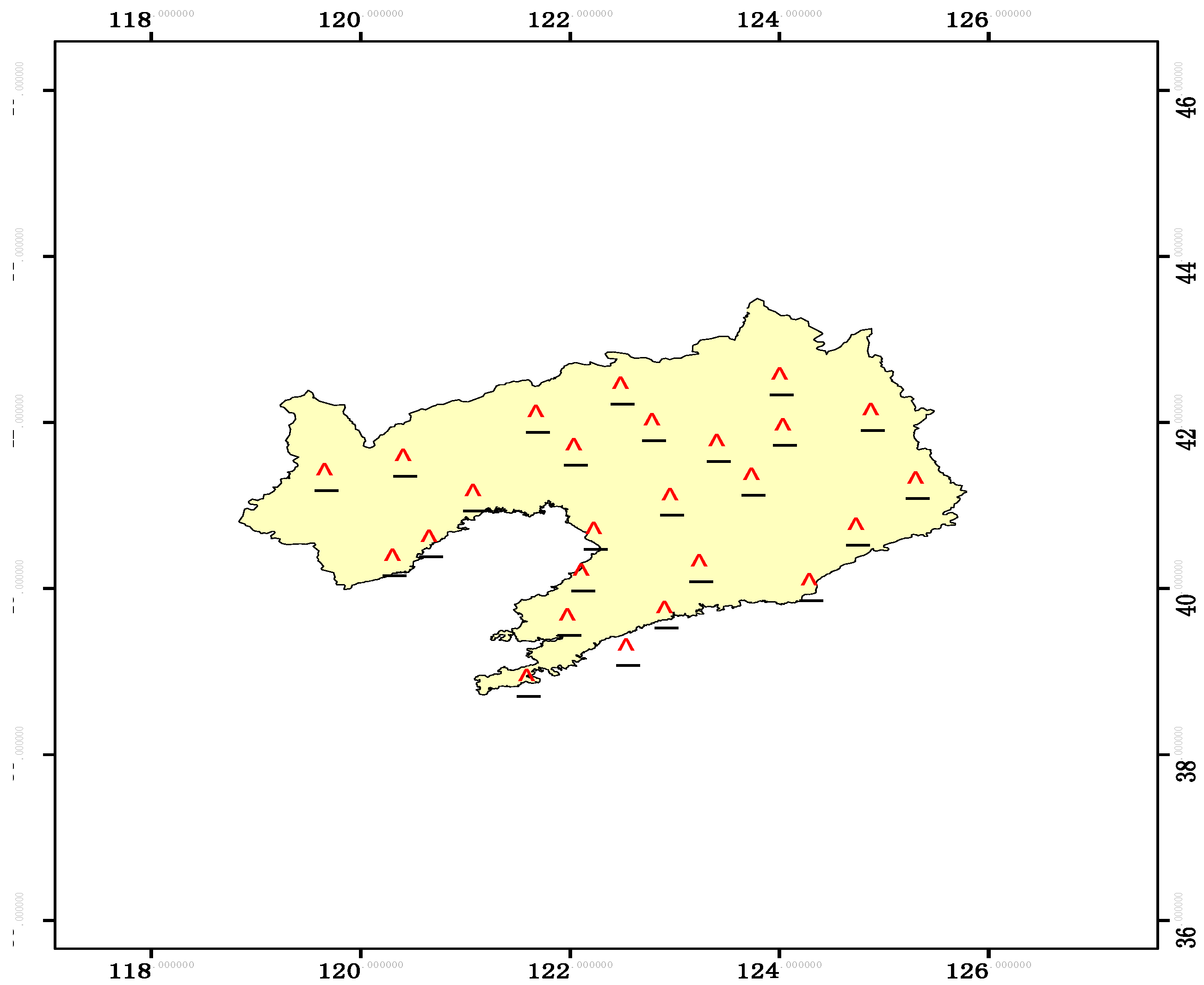
2.2.2. MODIS Data
2.3. Pre-Processing of MODIS Data
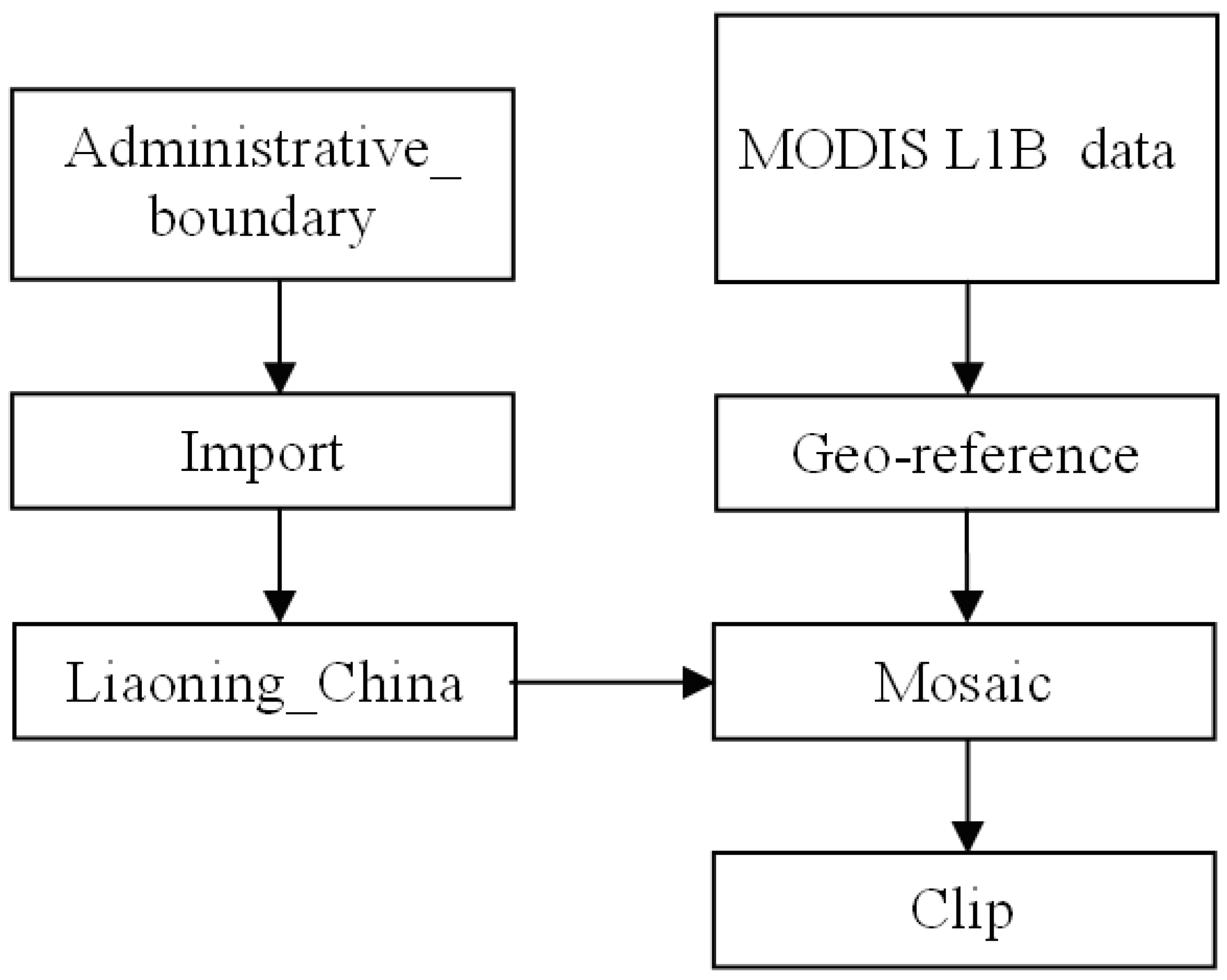
3. Methodology for Snow Mapping
3.1. Snow Mapping from Optical Remote Data
3.2. Snow Mapping in the Forested Areas
3.3. 8-Day Maximum Snow Extent Derived from MODIS L1B Data
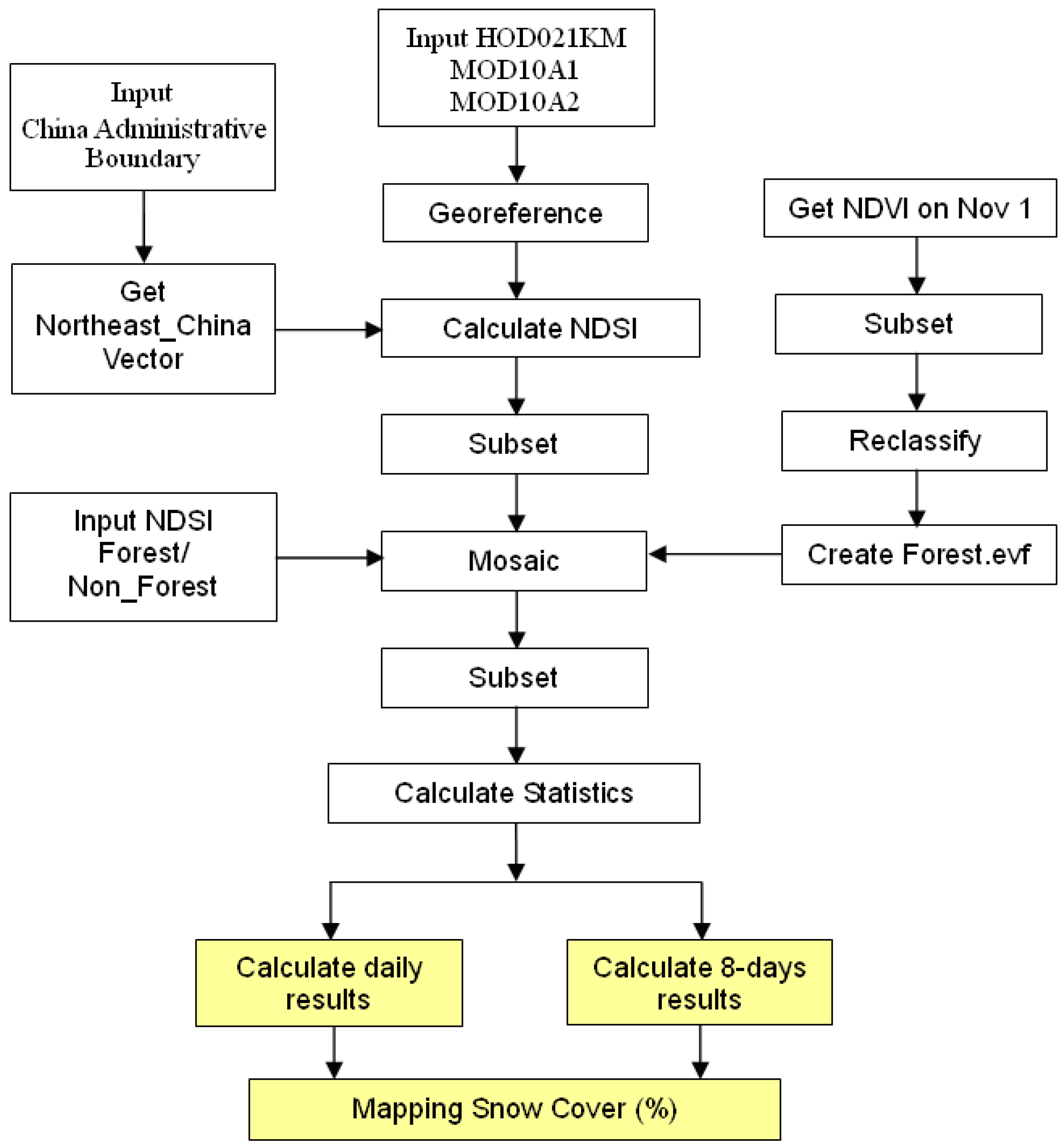

4. Results and Discussion
4.1. Daily Snow Mapping
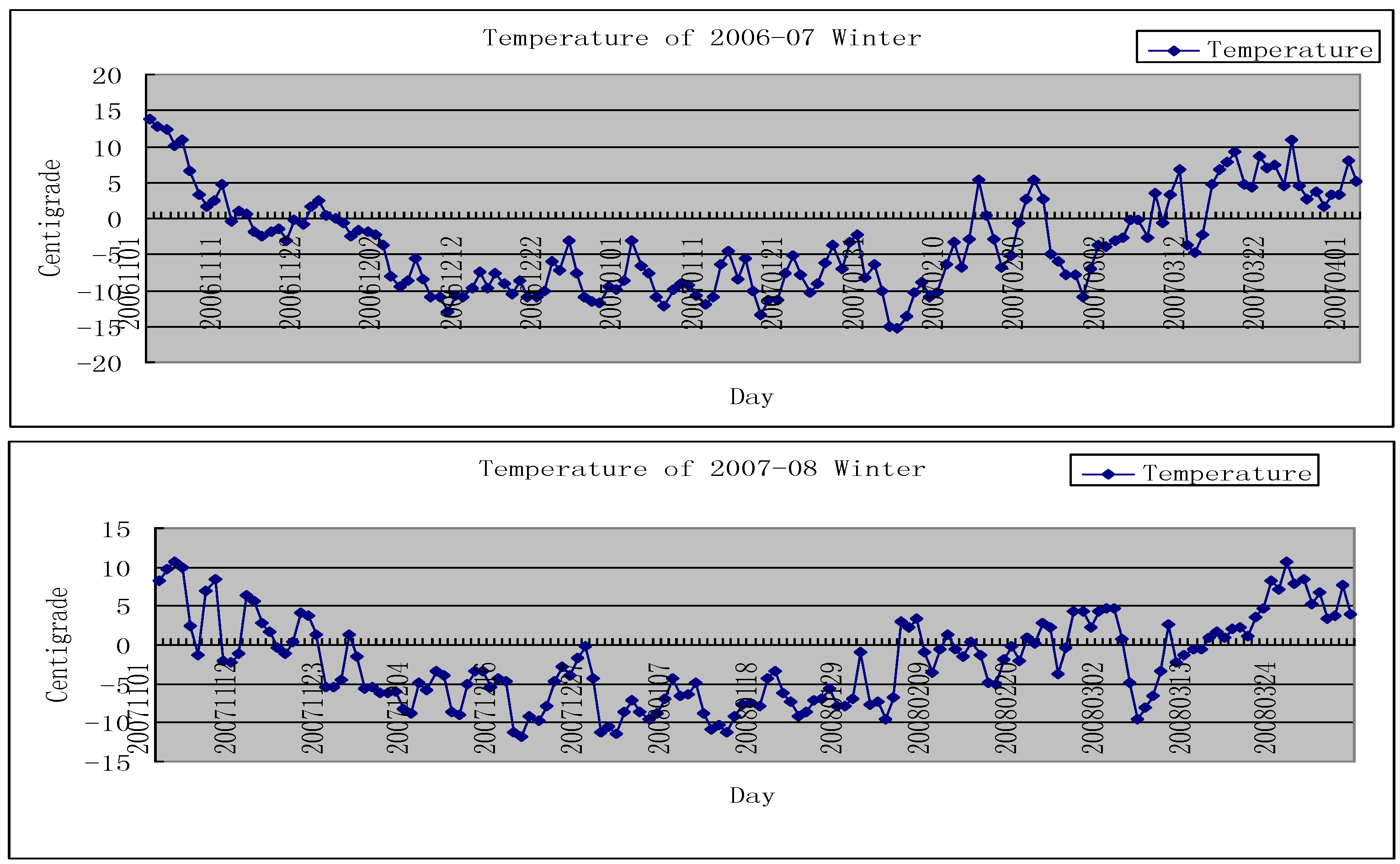
| Max. Percentage (2006–2007) | Max. Percentage (2007–2008) | |
|---|---|---|
| MODIS L1B | 0.92 | 0.70 |
| MODIS Snow Products | 0.50 | 0.50 |


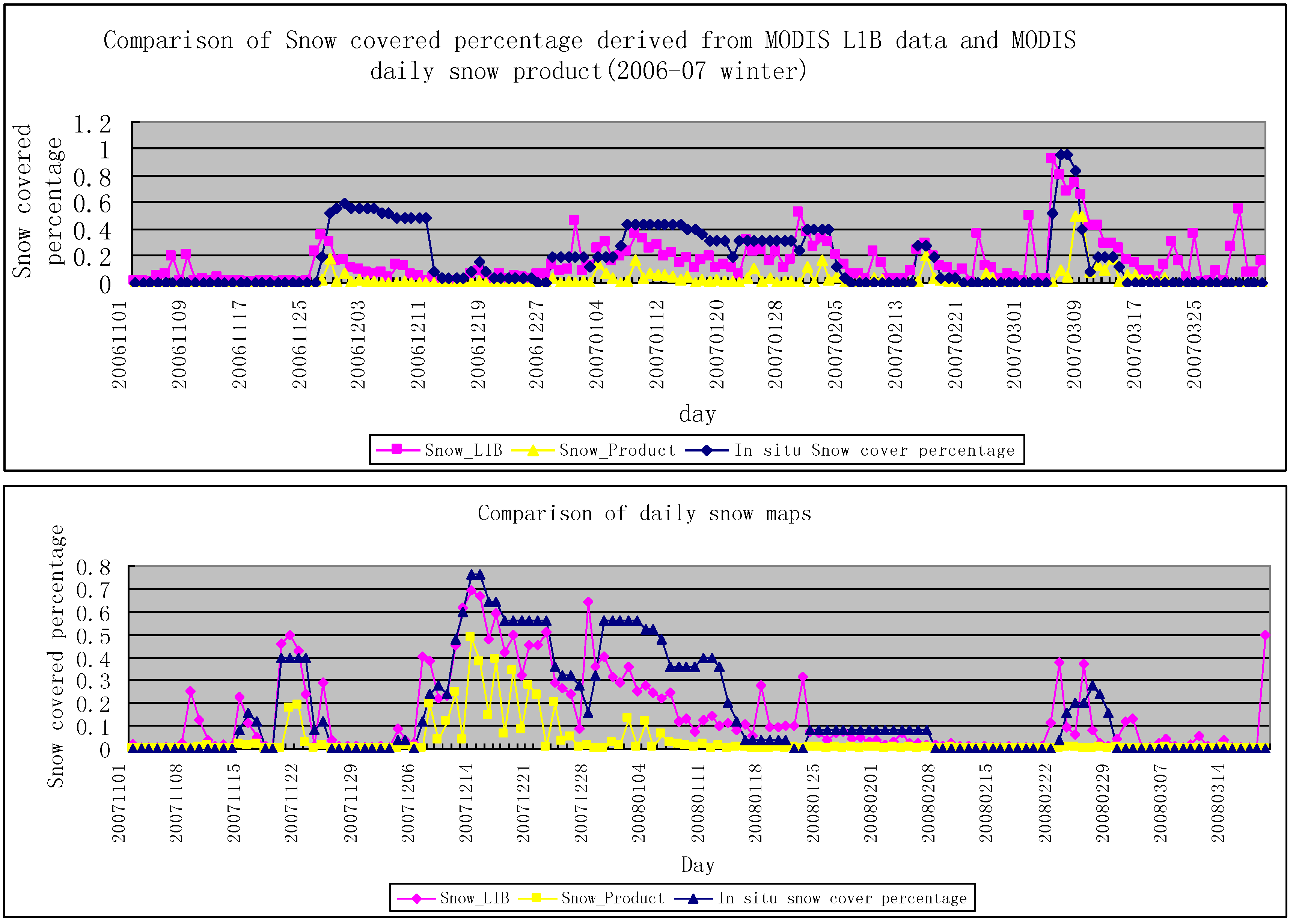
4.2. 8-Day Snow Cover Mapping
| Value | Meaning |
|---|---|
| ≥ 1 | Snow-covered area |
| 0 | Non snow-covered area |
| −1 | Frozen ground or ice ground |
| −2 | Melting |
| ≤−3 | Missing data |

| Value | Meaning |
|---|---|
| 1–8 | Snow-covered area |
| 0 | No Snow-cover |
| −2 | Cloud-obscured |
| −1 | Outside Liaoning Province |



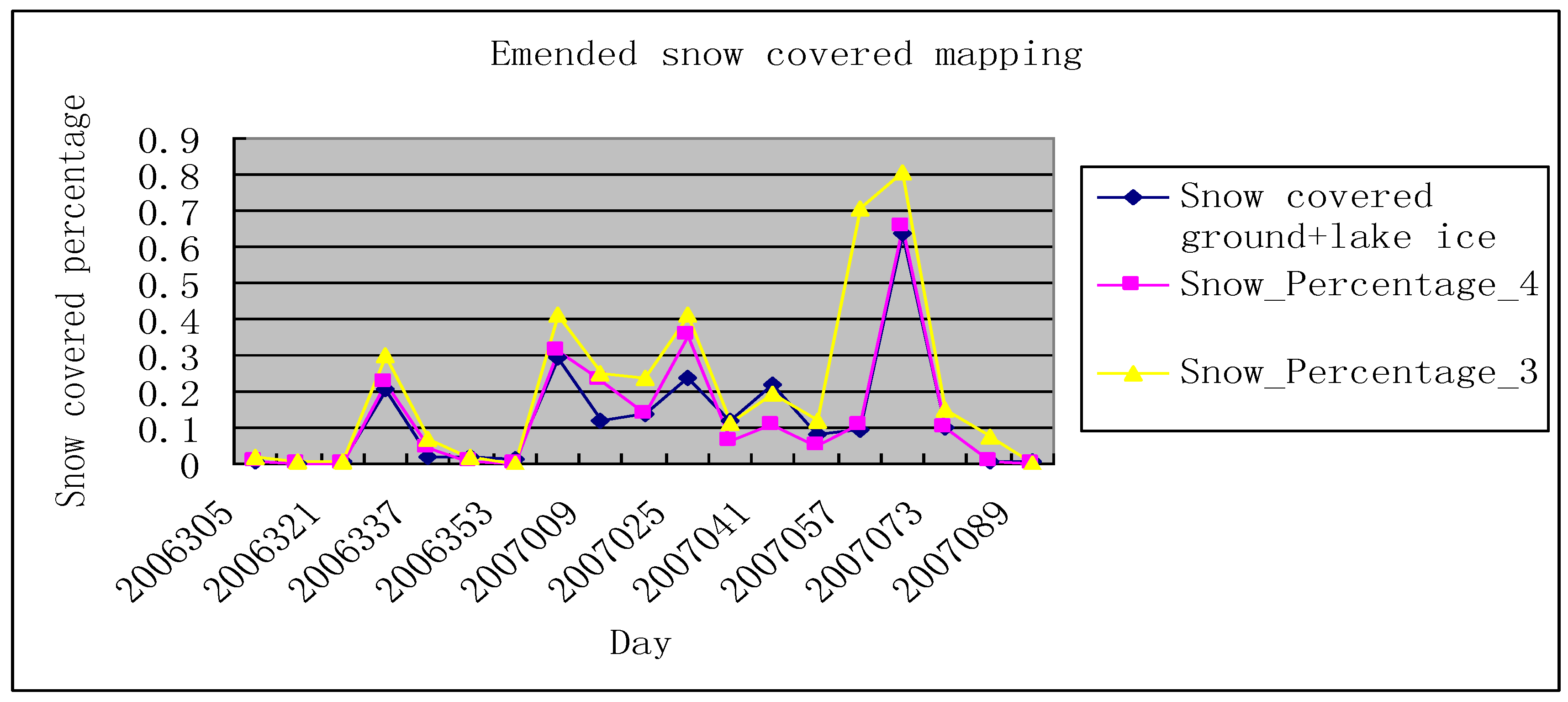


5. Conclusion
Acknowledgements
References
- Matson, M.; Ropelewski, C.F.; Varnardore, M.S. An Atlas of Satellite-Derived Northern Hemisphere Snow Cover Frequency; NOAA Atlas, US Department of Commerce: Washington, DC, USA, 1986. [Google Scholar]
- Rees, W.G. Remote Sensing of Snow and Ice; CRC Press, Taylor & Francis Group: Boca Rotan, FL, USA, 2006; pp. 99–117. [Google Scholar]
- Jin, Z.H.; Charlock, T.P.; Yang, P.; Xie, Y.; Miller, W. Snow optical properties for different particle shapes with application to snow grain size retrieval and MODIS/CERES radiance comparison over Antarctica. Remote Sens. Environ. 2008, 112, 3563–3581. [Google Scholar] [CrossRef]
- Rott, H.; Mätzler, C. Preface to microwave observations of snowpack and soil properties. Adv. Space Res. 1989, 9, 231–232. [Google Scholar] [CrossRef]
- Kurvonen, L.; Hallikainen, M. Influence of land-cover category on brightness temperature of snow. IEEE Trans. Geosci. Remote Sens. 1997, GE35, 367–377. [Google Scholar] [CrossRef]
- Hall, D.K.; Kelly, R.E.J.; Riggs, G.A.; Chang, A.T.C.; Foster, J.L. Assessment of the relative accuracy of hemispheric-scale snow-cover maps. Ann. G1aciolog. 2002, 34, 24–30. [Google Scholar] [CrossRef]
- Klein, A.G.; Hall, D.K.; Riggs, G.A. Global snow cover monitoring using MODIS. In Proceedings of 27th International Symposium on Remote Sensing of Environment, Tromsø, Norway, June, 1998; pp. 363–366.
- Vikhamar, D.; Solberg, R. A method for snow-cover mapping in forest by optical remote sensing methods. In Proceedings of EARSeL Specialist Workshop on Remote Sensing of Land and Snow, Dresden, Germany, 2000.
- Walker, A.E.; Goodison, B.E. Discrimination of a wet snow-cover using passive microwave satellite data. Ann. Glaciol. 1993, 17, 307–311. [Google Scholar]
- Liang, T.G.; Huang, X.D.; Wu, C.X.; Liu, X.Y.; Li, W.L.; Guo, Z.G.; Ren, J.Z. An application of MODIS data to snow cover monitoring in a pastoral area: a case study in Northern Xinjiang. Remote Sens. Environ. 2008, 112, 1514–1526. [Google Scholar] [CrossRef]
- Wang, X.; Xie, H.; Liang, T. Evaluation of MODIS snow cover and cloud mask and its application in Northern Xinjiang. Remote Sens. Environ. 2008, 112, 1497–1513. [Google Scholar] [CrossRef]
- Wang, J.; Li, H.Y.; Hao, X.H. Responses of snowmelt runoff to climatic change in an inland river basin, Northwestern China, over the past 50a. Hydrol. Earth Syst. Sci. 2010, 7, 493–528. [Google Scholar] [CrossRef]
- Lan, Y.C.; Wang, J.; Kang, E.S.; Ma, Q.J.; Zhang, J.S.; Chen, R.S. Snow cover monitoring by remote sensing and snowmelt runoff calculation in the upper Huanghe river basin. Chin. Geogr. Sci. 2002, 12, 120–125. [Google Scholar] [CrossRef]
- Song, K.S.; Zhang, Y. Snow-cover environmental monitoring and assessment in Northeastern China using passive microwave emission models. Environ. Monit. Assess. 2008, 140, 229–223. [Google Scholar]
- Song, K.S.; Zhang, Y.Z.; Jin, C.; Yan, S.; Chiu, L.S. Seasonal snow monitoring in Northeast China using space-borne sensors: preliminary results. Ann. Geogr. Inf. Sci. 2008, 14, 113–119. [Google Scholar] [CrossRef]
- Zhang, Y.S.; Ban, X.; Ji, R.; Yuan, G.; Feng, R.; Zhang, S. Analysis of Climatic Resources in Liaoning Province. Meteorol. Sci. Tech. 2004, 32, 33–43. [Google Scholar]
- Ji, R.P.; Zhang, Y.; Feng, R.; Chen, P.; Zhang, S.; Wu, J. Analyzing the changing characteristics of agricultural climate resources in Liaoning Province. Resour. Sci. 2007, 29, 74–82. [Google Scholar]
- Zhao, S.Y. Analysis of remote sensing applications. In Principles and Methods; Science Press: Beijing, China, 2003. [Google Scholar]
- Parajka, J.; Bloschl, G. The value of MODIS snow-cover data in validating and calibrating conceptual hydrologic models. J. Hydrol. 2008, 358, 240–258. [Google Scholar] [CrossRef]
- Armstrong, R.L.; Brodzik, M.J.; Savoie, M.H. Enhanced snow cover mapping using combined optical and passive microwave data. In Proceedings of International Geoscience and Remote Sensing Symposium, Anchorage, AK, USA, September, 2004; pp. 861–864.
- Kelly, R.E.J.; Chang, A.T.C.; Tsang, L.; Foster, J.L. A prototype AMSR-E global snow area and snow depth algorithm. IEEE Trans. Geosci. Remote Sens. 2003, GE41, 230–242. [Google Scholar] [CrossRef]
- Dozier, J. Snow reflectance from Landsat-4 Thematic Mapper. IEEE Trans. Geosci. Remote Sens. 1984, GE22, 323–328. [Google Scholar] [CrossRef]
- Dozier, J. Spectral signature of Alpine snow cover from the Landsat Thematic Mapper. Remote Sens. Environ. 1989, 28, 9–22. [Google Scholar] [CrossRef]
- Hall, D.K.; Riggs, G.A.; Salomonson, V.V. Development of methods for mapping global snow cover using moderate resolution imaging spectroradiometer data. Remote Sens. Environ. 1995, 54, 127–140. [Google Scholar] [CrossRef]
- Hallikainen, M.T.; Jolma, P.A. Retrieval of the water equivalent of snow cover in Finland by satellite microwave radiometry. IEEE Trans. Geosci. Remote Sens. 1986, GE24, 855–865. [Google Scholar] [CrossRef]
- Ma, Y.J.; Zuo, H.C.; Zhang, Y.H.; Hui, X.Y. Analyses on variation trends of atmospheric visibility and its effect factor in multi-cities in Central Liaoning. Plateau Meteorol. 2005, 24, 623–628. [Google Scholar]
© 2010 by the authors; licensee Molecular Diversity Preservation International, Basel, Switzerland. This article is an open-access article distributed under the terms and conditions of the Creative Commons Attribution license (http://creativecommons.org/licenses/by/3.0/).
Share and Cite
Zhang, Y.; Yan, S.; Lu, Y. Snow Cover Monitoring Using MODIS Data in Liaoning Province, Northeastern China. Remote Sens. 2010, 2, 777-793. https://doi.org/10.3390/rs2030777
Zhang Y, Yan S, Lu Y. Snow Cover Monitoring Using MODIS Data in Liaoning Province, Northeastern China. Remote Sensing. 2010; 2(3):777-793. https://doi.org/10.3390/rs2030777
Chicago/Turabian StyleZhang, Yuanzhi, Su Yan, and Yu Lu. 2010. "Snow Cover Monitoring Using MODIS Data in Liaoning Province, Northeastern China" Remote Sensing 2, no. 3: 777-793. https://doi.org/10.3390/rs2030777




